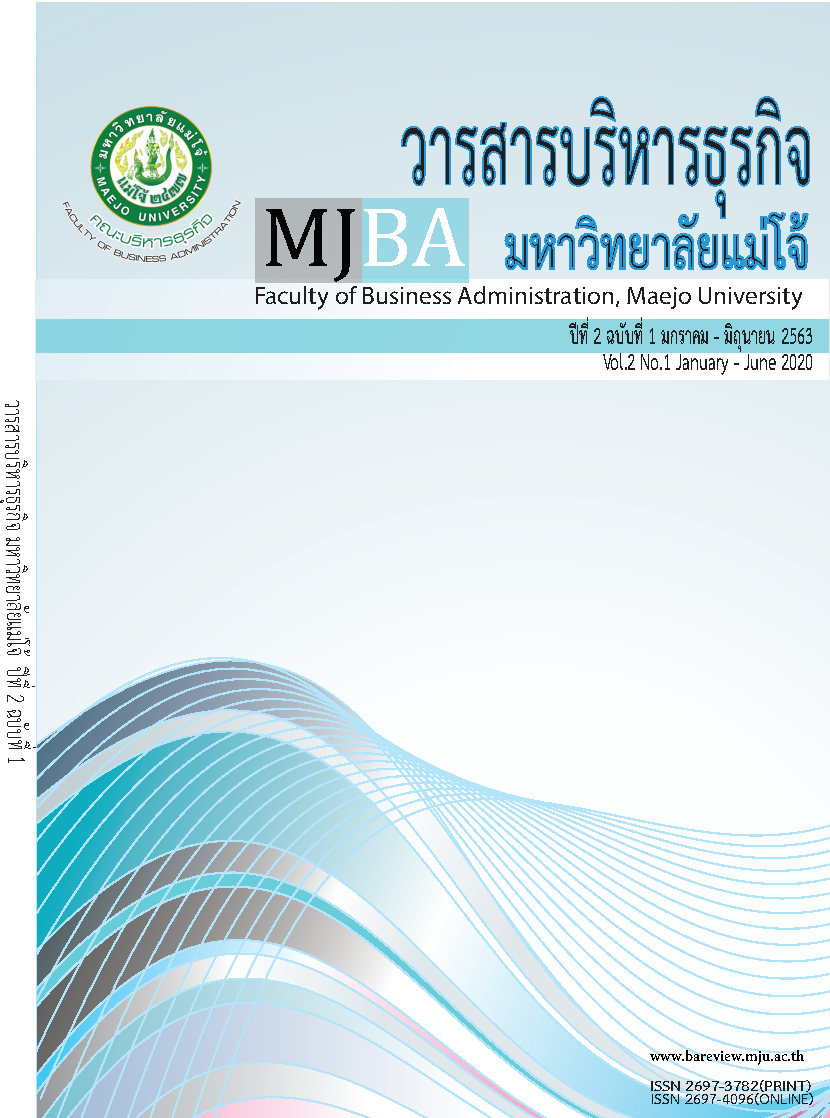การพยากรณ์ทางเศรษฐกิจของประเทศไทยโดยใช้ตัวแปรทำนายจำนวนมาก ที่มีความถี่แตกต่างกันEconomic Forecasting for Thailand using Predictors with Different Frequency
DOI:
https://doi.org/10.14456/mjba.2020.1คำสำคัญ:
แบบจำลองสมการถดถอยแบบ Elastic net, แบบจำลองสมการถดถอยแบบ MIDAS, ผลิตภัณฑ์มวลรวมภายในประเทศ, อัตราการเจริญเติบโตทางเศรษฐกิจบทคัดย่อ
การศึกษานี้ตรวจสอบการเติบโตทางเศรษฐกิจของประเทศไทยโดยใช้ตัวแปรทำนายจำนวนมากที่มีความถี่แตกต่างกัน (รายปีรายไตรมาสและรายเดือน) เราใช้วิธีการสุ่มตัวอย่างข้อมูลแบบผสม (MIDAS) เพื่อรวมข้อมูลความถี่ที่แตกต่างกันอย่างมากและยังใช้การถดถอยแบบริดจ์ LASSO และ Elastic net Regression เพื่อระบุว่าปัจจัยใดที่มีผลต่อการเติบโตทางเศรษฐกิจของประเทศไทย เรารวบรวมข้อมูลอนุกรมเวลาตั้งแต่เดือนมกราคม ปี 2000 ถึงธันวาคม ปี 2019 รวม 20 ปี ผลการวิจัยแสดงให้เห็นว่าอายุขัยและประชากรในเมืองมีผลกระทบเชิงลบต่อการเติบโตทางเศรษฐกิจ ในขณะที่มูลค่าเพิ่มของอุตสาหกรรมทำให้การเติบโตทางเศรษฐกิจเพิ่มขึ้น
เอกสารอ้างอิง
Abeysinghe, T., & Rajaguru, G. (2004). Quarterly real GDP estimates for China and ASEAN4 with a forecast evaluation. Journal of Forecasting, 23(6), 431-447.
Acemoglu, D. (2009). The crisis of 2008: structural lessons for and from economics. Globalization and Growth, 37.
Acemoglu, D., Johnson, S., & Robinson, J. A. (2002). Reversal of fortune: Geography and institutions in the making of the modern world income distribution. The Quarterly journal of economics, 117(4), 1231-1294.
Ali, S., Alam, K. J., & Islam, M. S. (2016). Effects of trade openness and industrial value added on economic growth in Bangladesh. International Journal of Sustainable Development Research, 2(2), 6.
Andreou, E., Ghysels, E., & Kourtellos, A. (2010). Regression models with mixed sampling frequencies. Journal of Econometrics, 158(2), 246-261.
Barua, A., & Chakraborty, D. (2006, July).
Barua, A., & Chakraborty, D. (2006, July). Liberalization, trade and industrial performance: an empirical analysis for India. In paper for the 2nd APEA Conference, held at the Center for International Economics, University of Washington, Seattle.
Clements, M. P., & Galvão, A. B. (2008). Macroeconomic forecasting with mixed-frequency data: Forecasting output growth in the United States. Journal of Business & Economic Statistics, 26(4), 546-554.
Cooray, A. (2009). Government expenditure, governance and economic growth. Comparative Economic Studies, 51(3), 401-418.
Durlauf, S. N., Kourtellos, A., & Minkin, A. (2001). The local Solow growth model. European Economic Review, 45(4-6), 928-940.
Ferrara, L., & Marsilli, C. (2013). Financial variables as leading indicators of GDP growth: Evidence from a MIDAS approach during the Great Recession. Applied Economics Letters, 20(3), 233-237.
Ghysels, E., Sinko, A., & Valkanov, R. (2007). MIDAS regressions: Further results and new directions. Econometric Reviews, 26(1), 53-90.
Ghysels, G., & Valkanov, R. (2006). Linear time series processes with mixed data sampling and MIDAS regression models. mimeo.
Grabova, P. (2014). Corruption impact on Economic Growth: An empirical analysis. Journal of Economic Development, Management, IT, Finance, and Marketing, 6(2), 57.
Hicks, J. (1969). A theory of economic history (Vol. 9). Oxford: Oxford University Press.
Li, J., & Chen, W. (2014). Forecasting macroeconomic time series: LASSO-based approaches and their forecast combinations with dynamic factor models. International Journal of Forecasting, 30(4), 996-1015.
Marcellino, M., & Schumacher, C. (2010). Factor MIDAS for nowcasting and forecasting with ragged‐edge data: A model comparison for German GDP. Oxford Bulletin of Economics and Statistics, 72(4), 518-550.
Maestas, N., Mullen, K. J., & Powell, D. (2016). The effect of population aging on economic growth, the labor force and productivity (No. w22452). National Bureau of Economic Research.
Rodrik, D. (2000). Institutions for high-quality growth: what they are and how to acquire them. Studies in comparative international development, 35(3), 3-31.
Svensson, J. (2003). Why conditional aid does not work and what can be done about it?. Journal of development economics, 70(2), 381-402.
Thianpaen, N., Liu, J., & Sriboonchitta, S. (2016). Time series forecast using AR-belief approach. Thai Journal of Mathematics, 14(3), 527-541.
The Office for National Statistics. (2019, November 1). Calculation of GDP. Retrieved from https://www.ons.gov.uk/
Tiffin, A. (2016). Seeing in the dark: a machine-learning approach to nowcasting in Lebanon.

ดาวน์โหลด
เผยแพร่แล้ว
รูปแบบการอ้างอิง
ฉบับ
ประเภทบทความ
สัญญาอนุญาต
ลิขสิทธิ์ (c) 2020 วารสารบริหารธุรกิจ มหาวิทยาลัยแม่โจ้

อนุญาตภายใต้เงื่อนไข Creative Commons Attribution-NonCommercial-NoDerivatives 4.0 International License.






